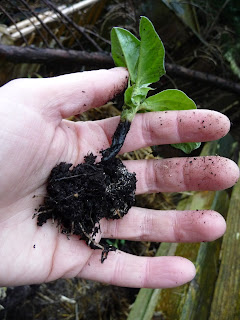So, what's better? Digging or rotavating? I think it's down to what works best for the individual and their needs. Here's a list of pros and cons:
Digging:
- You can choose to do a double dig or single dig or just aim to simply turn the soil.
- Weeds can be removed in whole pieces (the areas where I dig more thoroughly tend to have less weeds each year as I don't leave any roots in the soil).
- You can incorporate manure or compost into your soil when digging.
- But you can ache after the hard work.
- It can take up a lot of time too.
- It's quick and therefore covers a lot of ground in very little time.
- It breaks the soil up quite well.
- But it's not a cheap machine to buy and you might need to hire one (unless you know someone that has a rotavator).
- Annoyingly, weeds can get broken up and growing again, and I've had bindweed being dispersed further by the rotavator just spreading the weed's roots everywhere.
It really didn't take too long (apart from running out of petrol at one point).
The broad beans had to go out. I thought that I could wait a little longer with the last of them but they were fast outgrowing their pots as the weather's become warmer and I was also running out of space and as we're moving in to April very soon, I needed that space for more sowings.
The one thing that I find a hurdle on the allotment is the windy weather. Being so exposed I'm always on the lookout for plants that can take being battered by the elements. The first planting of broad beans was looking worn out already so I bought some small bamboo sticks and twine to create supports. I'm pleased to say that they are working! I'm not the neatest of gardeners so my lines of beans are so far wonky. But what are looks on an allotment where practicality overcomes aesthetics? I'm just happy that I have many beans growing but the danger of losing them is not yet over. There are signs of deer nearby and even though it'a warm right now, there could be frost. Did I ever say that gardening was easy? Strangely, despite the potential set backs, I still really enjoy gardening.
So, what did I finish with this week? The broad beans are now all in at the allotment. Carefully supported by just tying twine to bamboo sticks either side of the plants seems to be doing the trick. The original frost cover for the peas was in tatters so I had to use some more bamboo sticks and twine to create a lower support and then fixed another cover on top for now (while the peas are still quite small). The lower frost cover shouldn't be damaged by the wind. I also managed to get some onion sets in although I'm behind with planting garlic, which I'm really cross with myself for.
All ready for planting. The bamboo sticks were £1 for 50 from Poundland,
The new cover for the peas and my broad beans with some support.
A closer look at the support. In the background you can see the old pea cover, not looking its best.
Back at home I've been working a bit in the polytunnel. As there's protection from any potential frost, I've planted out my early tomatoes into the second raised bed, where I had buried some fresh duck manure back in November. Just to be on the safe side, I've covered the smaller tomatoes with plastic bottles, which should keep them safe from any pests as well. I first used plastic bottles when I started growing sweetcorn as they were a good way of protecting the young plants very much like any other cloche would. So, much to my husband's dislike I've been stashing away plastic bottles among other 'useful' items for my garden work.
As for any other seeds, I've sown more beans (not broad this time). The dwarf French bean amethyst and a dwarf borlotti bean, saluggia. I tried growing borlottis last year but failed after a frost got to them and I didn't have enough time to sow any more. French beans I love to grow as the kids really enjoy eating them and they never seem to get bored of them.
One of my tomatoes, red cherry, without a bottle cloche. Just in the corner is one plant with a cover. These plants are about 15cm tall already.
So on with more planning. I aim to pot on some flowers that I'm growing and sow far more vegetable seeds. I need to clean out the greenhouse and poly properly and continue digging the plot, should my back allow me to!
Keep up the hard work as the weather is improving and the nights are drawing out more now. It's just going to get far better from now on! Till next time.



















































